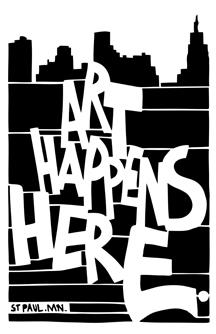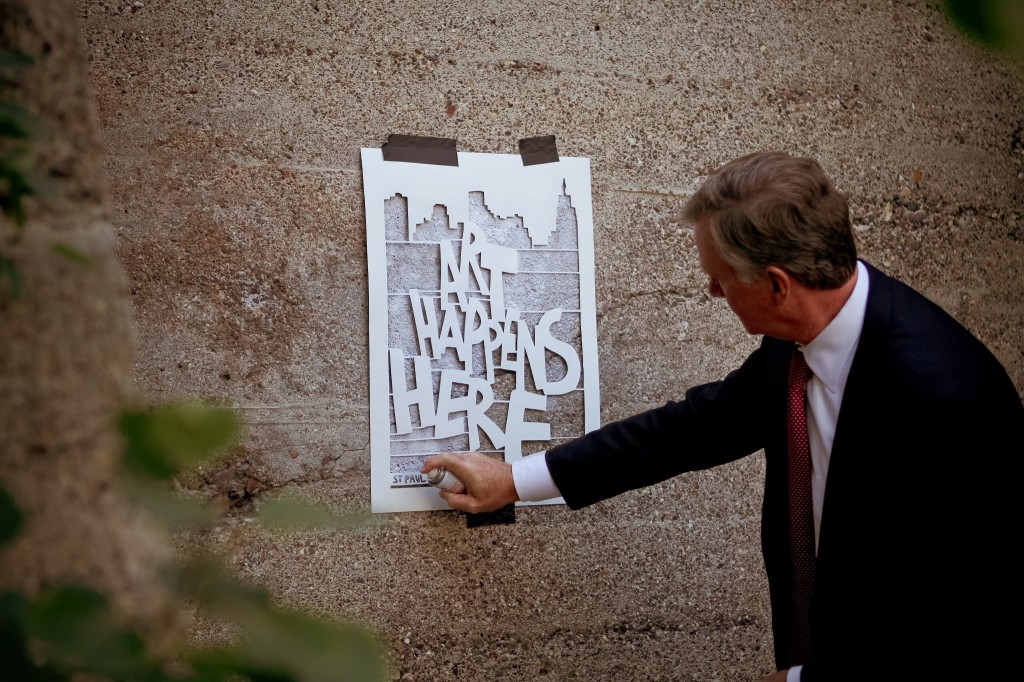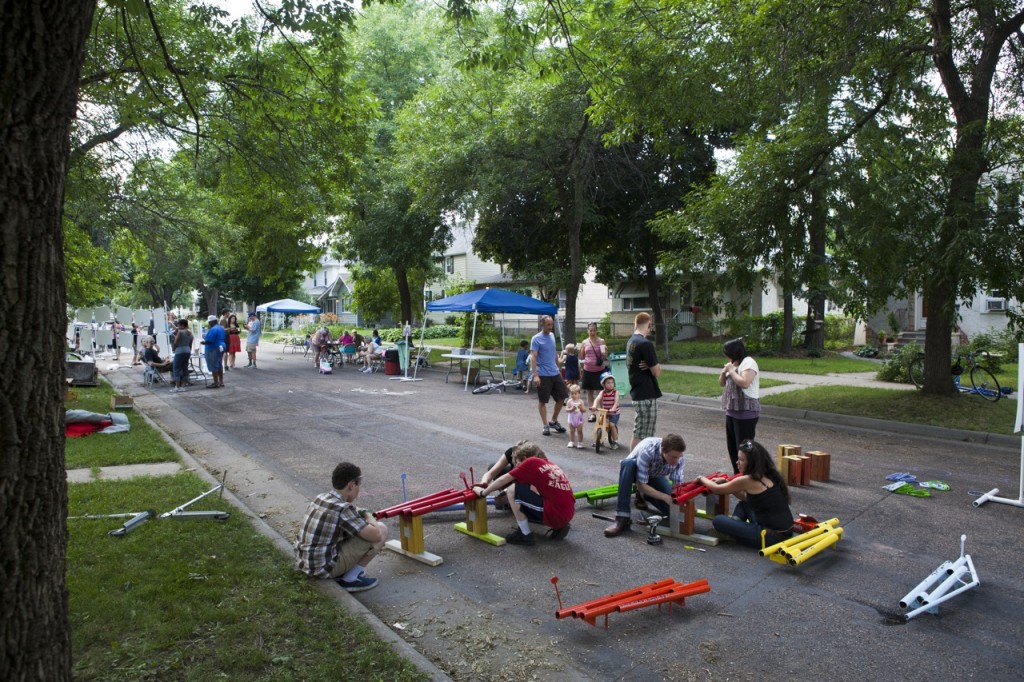
A plan to “Irrigate” St. Paul’s economic development through the arts
St. Paul has been abuzz about the idea of “creative placemaking” in the last couple of weeks. Basically, the idea centers on encouraging cross-sector innovation for the sake of community and economic development by strategically engaging a city’s artists and cultural organizations. It’s “the act of people working together to change overlooked and undervalued public spaces into places where the community gathers, supports one another and thrives.” There’s a white paper on the subject, commissioned by the National Endowment for the Arts (NEA) and available online, if you’re interested in reading more. (PDF)
Now, thanks to a $750,000 grant from ArtPlace, our city is about to see “creative placemaking” put into action in a big way, specifically targeted to communities impacted by major infrastructure work currently underway in the heart of the city. ArtPlace is a public/private endeavor, including 11 major philanthropic foundations (among them the John S. and James L. Knight Foundation), the National Endowment for the Arts and several federal agencies; this coalition of funders is providing seed money and support for this and other arts-led community development programs across the country.
This significant investment in St. Paul — which, between the ArtPlace grant and additional, independent fundraising efforts, comes to nearly a million dollars — is intended to galvanize a new artist-led economic development program along the city’s six-mile stretch of “Central Corridor” light rail construction. The program, called Irrigate, is a joint project of Springboard for the Arts (a Knight Arts grantee), the City of St. Paul and Twin Cities Local Initiatives Support Corporation. Irrigate plans to actively enlist the city’s arts community and put them to work in Central Corridor neighborhoods, training artists to lead community development efforts on behalf of the area’s affected businesses and residents, with the aim of encouraging cultural vitality and fueling economic growth in those neighborhoods during the construction process and beyond.
I asked two principals on the Irrigate team — Joe Spencer, the city of St. Paul’s director of Arts and Culture, and Laura Zabel, executive director of Springboard for the Arts — to elaborate on their plans and their hopes for the program, now and going forward.
Susannah Schouweiler: What tangible benefits do you think Irrigate might offer the neighborhoods in St. Paul — short- and long-term?
Joe Spencer: One key priority of our program design for Irrigate is that we focus on having an impact immediately. The training and workshops will start later this month, and I’m hopeful we’ll start to see artist-led projects begin implementation right away. These projects will bring whimsy, fun and interest to the immediate construction zone, which will attract more people and will make these areas more vibrant. Over the long term, I think Irrigate will establish an identity for Central Corridor as a place shaped by and tailored for creative people and artists. We know from our experiences with Lowertown that this will drive economic and social vitality. It attracts and grows jobs, residential population and social opportunities. We also know we can achieve this by focusing on the people who are already in these neighborhoods, so they are the primary beneficiaries.
SS: What about St. Paul residents and businesses outside the immediately affected “trench” area of light rail construction? Any advantages for them?
JS: Having a strong creative spine that stretches through the heart of Saint Paul will do two things for all parts of Saint Paul: a) It will bring that vitality and vibrancy closer to most neighborhoods; and b) with more vitality and more vibrant neighborhoods, we become a more attractive city for the entrepreneur to start her new business or for the young professional to start his career. Additionally, we are considering Irrigate a pilot or test model; based on our experience, it is a strategy that will likely be implemented across the city.
SS: What will the artist workshops and training sessions for Irrigate entail? What skills, specifically, are you aiming to give the creative people in these communities?
Laura Zabel: The workshops, which will begin in mid-October, will include principles of creative placemaking and community development. These workshops will be conducted in partnership with the St. Paul District Councils, so they will also include information about the particular issues, opportunities and challenges in the Central Corridor right now. Through the workshops, artists will be able to connect with business owners, neighborhood organizations and others who are interested in working with an artist on a particular challenge. SS: What might an artist-led initiative in a Central Corridor neighborhood look like? Have you gotten any ideas or feedback from people living there yet?
LZ: There will be hundreds of projects that result from these workshops and the subsequent project support that is available. We expect that these projects will include creative marketing ideas like events, signage and mapping; projects that help residents shape the identity of their neighborhoods; and other events and activities that draw people to the corridor.
JS: People of all stripes have been very excited about this project. Because the project was designed in such a way that it is artist-led and scaled to a very grassroots level, we don’t entirely know what the projects will be. People are very curious and eager to see what it will look like.
SS: What would success look like for Irrigate, and how do you plan to measure it?
JS: Success will look like neighborhoods along the corridor (including Downtown and Lowertown) filled with people and fun. We will measure it with vacancy rates, head counts and new creative assets, but also with popular opinion and media portrayals.
LZ: In the short term, we will measure success by the number of people we are able to attract to the corridor, the number of businesses and neighborhood groups we are able to provide with creative solutions and the number of artists we are able to train to do this kind of work. In the long term, our success will be measured by the reciprocal relationships that are built between communities and their artists, and the ways in which this kind of work continues without us. We are out to change the way that communities value and rely on their artists.
SS: Finally, you must be fielding this question: In economic times like these, when so many other kinds of programs and services are in need, why spend nearly a million dollars on arts initiatives?
JS: Based on our success, and based on research like Knight’s “Soul of the Community”, we know that these are effective investments for economic development. This project is exciting, in particular, because it’s not an ‘arts initiative’ so much as it’s an arts-based and artist-led community development initiative. This work is needed specifically because of these economic times.
LZ: The economic development goals of this project are explicit. Irrigate is about mobilizing artists as a creative force to help address issues during transit development. I’m fond of saying that this isn’t a project about artists asking for more, it’s about helping communities ask more from their artists. I believe that as a community, and as a culture, we are in need of more creative thinking, particularly when it comes to economic development. Irrigate seeks to engage artists as a part of the city’s goals in liveability, vibrancy and health.
Find out about the various artist-led programs, community development workshops and related events underway in St. Paul on the Irrigate website and on the organization’s Facebook page. Learn more about similar initiatives around the country and the foundations, arts organizations and affiliate federal agencies working to make it happen on the ArtPlace website.
Recent Content
-
Artsarticle ·
-
Artsarticle ·
-
Artsarticle ·





